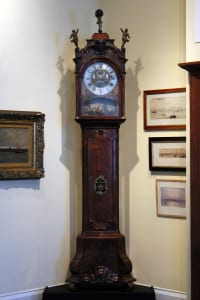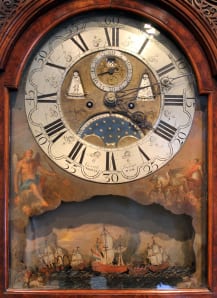Conservation Spotlight: 18th Century Dutch Clock

The New Bedford Whaling Museum has restored to working order one of the largest and oldest clocks in its collection. It is currently on display in the Museum’s Grimshaw-Gudewicz Reading Room
The massive clock, which stands nine feet tall and was once part of the Kendall Whaling Museum before it came to New Bedford, has a deep connection to the city, which dates to the eighteenth century. Owned by Samuel Rodman (1753-1835) and his wife Elizabeth Barney Rotch Rodman (daughter of William Rotch), the clock may have been specially made for William Rotch as early as 1754 and may have been a wedding gift to his daughter and son-in-law in 1780.
Built by Gerrit Knip, considered “the most fashionable clockmaker and watchmaker in Amsterdam”, the clock was part of the Samuel Rodman household when it moved in the 1790s from Nantucket to New Bedford. It was inherited by Samuel Rodman, Jr. and wife Hanna Prior Rodman, and descended thereafter in the Rodman and Rotch families. Knip was at the height of his career in the 1780s, renowned for his intricate cases and mechanisms.
The elaborate clockworks circa 1760-80 include a mechanically animated whaling fleet bounding through an Arctic seascape. The highly decorated long-case of burled walnut, silvered brass mounts, blind fretwork, and brass column capitals is done in the Amsterdam style and features oil-on-metal painted decoration of Arctic whaling and polar bear hunting scenes.

Built by Gerrit Knip, a clockmaker in Amsterdam, this clock was part of the Samuel Rodman household when it moved in the 1790s from Nantucket to New Bedford.
The figure of Atlas at the center apex may possibly have been inspired by the monumental sculpture by Arthus Quellinus for what is currently the Royal Palace at Dam Square in Amsterdam, and flanked by archangel finials. The eight-day pendulum movement is weight-driven and strikes the hour, quarter-hour and half-hour. It also shows the days, date, phases of the moon and the zodiac in Dutch. The decorations include a spouting whale, and mythological scenes of Helios pulling the sun across the sky in his chariot which rose and fell in the ocean stream Okeanus, overseen by Oceanus, who is pictured on the left.
The Museum contracted with Pen & Pendulum in Mattapoisett, Massachusetts, to undertake the repairs, which included father and son clock-makers, Arthur and Warren Hovasse fully disassembling, cleaning, fabricating new parts, and reinstalling the clock in the Braitmayer Family Gallery.
Supported in part by the Rose Lamb Gifford Fund, the repairs are the most comprehensive to date on the clock, which have included conservation of the case over several years. The clock had not been keeping time since the mid-1990s. “This is the first of several tall case clocks the museum hopes to bring back to life as part of a five year conservation plan,” said Christina Connett, Chief Curator.


